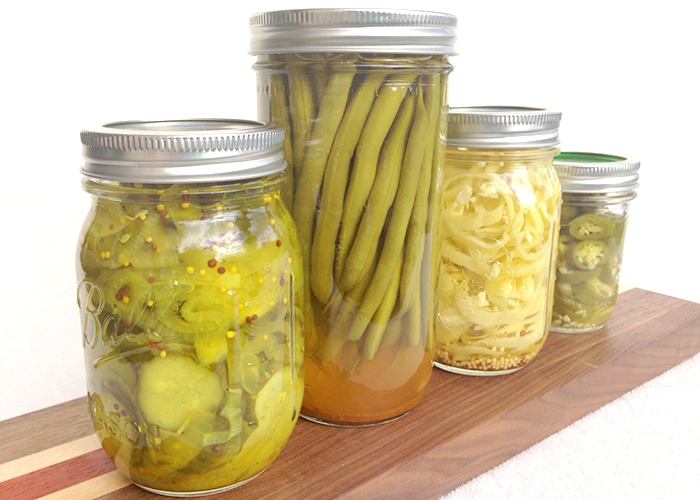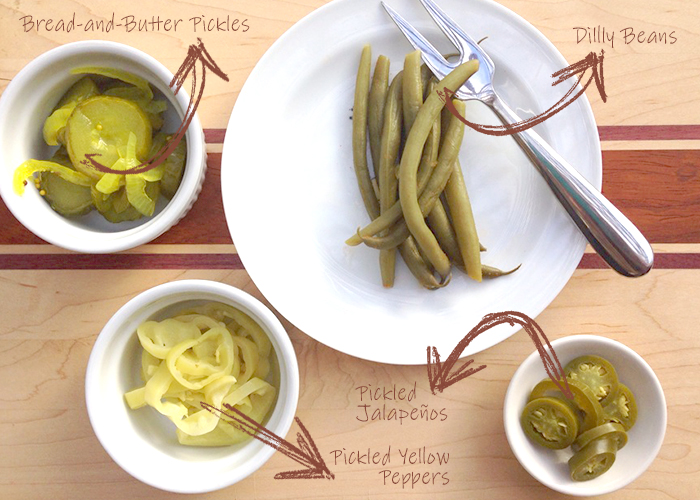Put ‘Em Up: Small Batch Canning
Posted on October 7, 2014 at 6:00 am
By Kim Harshberger
If hearing that someone cans conjures up images in your mind of dirt-packed cellars filled to the ceiling, you’re not alone. I too had that thought when I embarked into the world of canning. I would can all the things like Erica of Northwest Edible Life. This chick is hardcore and I have lots of respect for her larder, but I realize that’s not in the cards for me (yet).
While I have never contributed to a case of botulism, I have made my fair share of canning mistakes over the years. I have inadvertently maced myself with a batch of spicy dilly beans (that’s a story to be shared over a glass of wine). I have burned batches of jam (and had my skin seared by molten globs landing on my feet). But my biggest mistake was thinking that I had to put up all the produce so that my family could survive the apocalypse. This resulted in a bad case of canning fatigue and, apparently, way more chutney than my family could ever eat. Go figure.
So, if you harbor in interest in beginning to can, you can learn from my mistakes and start out with some small-batch canning. My theory is that instead of making dozens of jars of applesauce, I can do 5-7 jars of this-and-that for a tasty variety in my pantry. I will typically plan to can for a whole day, because, let’s be honest, breaking out the canner, doing all the prep, and cleaning up is a whole lot of work for just six jars. I still want to get the most for my effort, just with more variety at the end of the day.
To date, I only water bath process. It doesn’t require much investment in equipment and I can have a lot of fun with the variety of fruit, jam, condiment, and pickle recipes available. You will want to make sure that the recipes are acidic enough to be safely water bath canned. As a beginner canner, the safest route is to make sure to use reputable sources for your canning recipes. I suggest beginning with the Ball website or their Blue Book Guide to Preserving. Another good resource is the National Center for Home Food Preservation.
Part of what spawned my big-batch frenzy was the year I ended up with over a bushel of tomatoes left in my garden when the first big freeze was on the way. I hastily picked all the tomatoes from my plants, many of which were still green and firm. While I was tempted to fry up some slices, I set out instead to find some creative canning recipes to deal with them.
I ended up making a lovely green tomato chutney from Paula Dean’s website (which doesn’t exist anymore, sadly). If you have never had the pleasure of chutney, it is a boldly spiced, sweet and sour mixture of fruits, typically used as a condiment. If you haven’t tried one, you might want to buy a jar first to make sure you like the concept since they can be fairly labor intensive. You will need to chop all the different ingredients and cook them through before you process in your canner. But as long as you aren’t trying to do *cough* 12 jars, it should be manageable for an intermediate level canner. I serve my chutney with ham, a family tradition. The salty, smoky ham is pair well with the sweet tang of the chutney. I have also served it atop a wedge of creamy, warm Brie for a sophisticated appetizer. Perfect for the holiday season.
That same year I also made a green tomato sweet relish. Calling for eight pounds, this recipe really used up my tomatoes! But I still have four pint jars left in my pantry. I personally love it on top of grilled jalapeño and cheese sausage with some grainy mustard. I also use my homemade relish in my tuna salad.
This year I have spent several days doing jams; strawberry, apricot, and a lovely raspberry/blueberry. I also spent one whole day doing a variety of the following pickled recipes. I specifically planned a day of pickling because there isn’t much prep, they all take similar ingredients, and you can do small batches easily.
Basic Pickled Jalapenos from Food In Jars
Makes 5 half-pint jars
Since I still have young kids, I don’t always get to make food as spicy as I like. So being able to add these little rings onto nachos, enchiladas, and chili can give me the spice I crave. For the adventurous, you might want to try my sister’s technique: she eats them on a slice of cheese. This is one of the easiest recipes to follow. The recipe calls for halved pepper but I opted to cut mine in rings for easier use. Do beware of getting these peppers on your hands (or in your eyes) when cutting them, I wear gloves and have soapy water on hand for clean up.
Dilly Beans from the Ball Blue Book Guide to Preserving
Makes 6 pint jars
This recipe is special to me because it is something that my grandma canned and reminds me of her. In addition to the ingredients in the recipe, I also add a teaspoon of cayenne pepper to each jar for a kick. This is the one recipe that I still make a big batch of (19 jars this year) because I have some family members that expect to receive several jars of these over the course of the year. Because there isn’t any cooking and little prep involved, I don’t mind. I usually serve these straight out of the jar while standing in front of my fridge. My sister puts them on her sandwiches and they always make an appearance on the holiday relish trays.
Bread-and-Butter-Pickles from Little Jars, Big Flavors
Makes 7 pint jars
This was my most labor-intensive recipe for the day since it takes food prep, sitting time, and cooking. With a little planning I was able to get this prepped first and put aside to stand and drain. These are just as delicious as I hoped. My family loves to snack on them with lunch.
Pickled Yellow Pepper Rings from Nation Center for Home Food Preservation
Makes 4 pint jars
At $6 a jar in the grocery store, I added these to my list so I could enjoy these tasty pickled peppers without breaking the bank. I have a sausage, potato, and pepper recipe that uses pepperoncinis and they really make the dish. And who wouldn’t want to have some peppers on the side of a Greek salad. Yum!
Fall is upon me and canning season is quickly coming to a close, but I would still like to put up some pickled beets and a variety of mustard. I look forward to enjoying my tasty treats throughout the long winter and I think many of these will make great holiday and hostess gifts.
Tags: canning, DIY, food, food preservation



